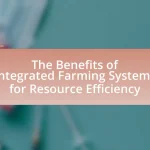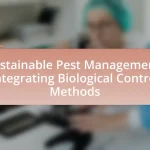Sustainable livestock management is a strategic approach aimed at optimizing livestock production while minimizing environmental impacts, particularly greenhouse gas emissions. This article outlines key practices such as rotational grazing, improved feed efficiency, and integrated crop-livestock systems that contribute to reducing methane and nitrous oxide emissions. It discusses the principles of sustainable livestock management, the significant role of livestock production in climate change, and the importance of effective manure management. Additionally, the article addresses the challenges farmers face in adopting sustainable practices and highlights the role of technology and data analytics in enhancing livestock management efficiency.
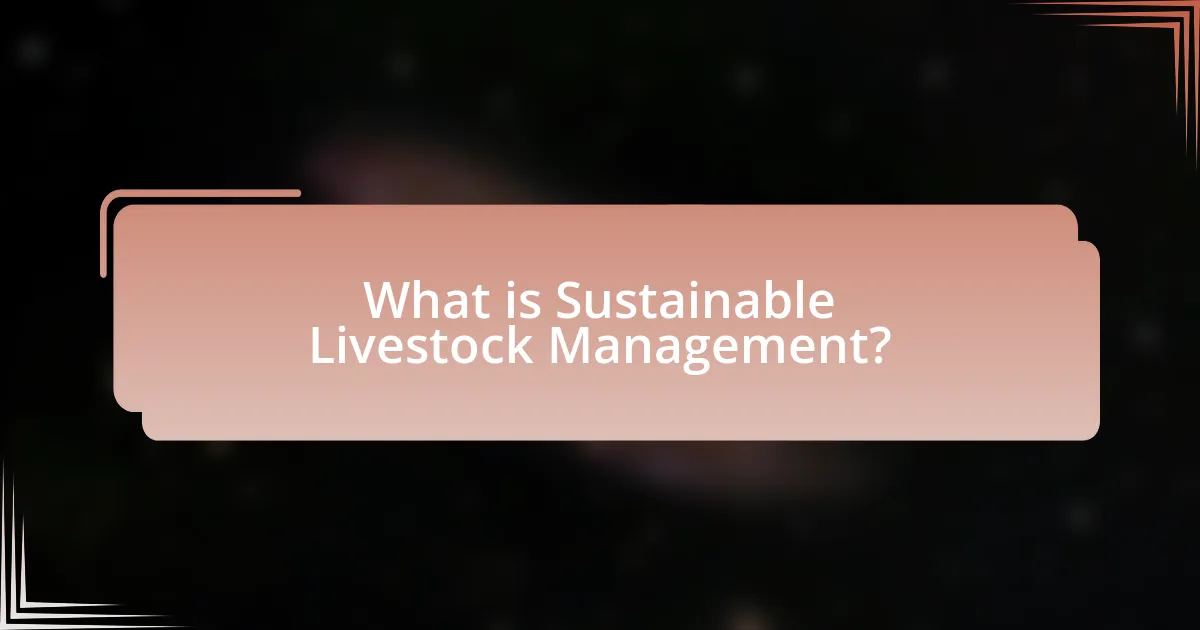
What is Sustainable Livestock Management?
Sustainable livestock management is an approach that aims to optimize livestock production while minimizing environmental impact, particularly greenhouse gas emissions. This management practice incorporates techniques such as rotational grazing, improved feed efficiency, and integrated crop-livestock systems, which collectively enhance animal welfare and reduce carbon footprints. Research indicates that implementing sustainable practices can lead to a significant reduction in methane emissions, with studies showing that proper pasture management can decrease emissions by up to 30%.
How does Sustainable Livestock Management contribute to reducing greenhouse gas emissions?
Sustainable Livestock Management contributes to reducing greenhouse gas emissions by implementing practices that enhance efficiency and minimize waste. For instance, rotational grazing improves soil health and carbon sequestration, while optimized feed formulations reduce methane production during digestion. Research indicates that adopting these practices can lower emissions by up to 30% in some livestock systems, as shown in a study by the Food and Agriculture Organization, which highlights the potential for sustainable practices to significantly mitigate the environmental impact of livestock production.
What are the key principles of Sustainable Livestock Management?
The key principles of Sustainable Livestock Management include efficient resource use, animal welfare, biodiversity conservation, and minimizing greenhouse gas emissions. Efficient resource use involves optimizing feed conversion and water usage to enhance productivity while reducing waste. Animal welfare emphasizes humane treatment and proper living conditions, which can lead to healthier livestock and improved productivity. Biodiversity conservation focuses on maintaining diverse ecosystems that support livestock health and resilience. Finally, minimizing greenhouse gas emissions is crucial; practices such as rotational grazing and improved manure management can significantly reduce the carbon footprint of livestock operations. These principles collectively contribute to a more sustainable and environmentally friendly approach to livestock management.
How does livestock production impact greenhouse gas emissions?
Livestock production significantly contributes to greenhouse gas emissions, primarily through methane and nitrous oxide release. Methane, produced during digestion in ruminants like cows, has a global warming potential over 25 times greater than carbon dioxide over a 100-year period. Additionally, nitrous oxide emissions arise from manure management and the use of synthetic fertilizers in feed production, with a global warming potential nearly 300 times that of carbon dioxide. According to the Food and Agriculture Organization, livestock accounts for approximately 14.5% of global greenhouse gas emissions, underscoring the critical need for sustainable management practices to mitigate these impacts.
Why is Sustainable Livestock Management important for the environment?
Sustainable livestock management is important for the environment because it reduces greenhouse gas emissions and promotes biodiversity. By implementing practices such as rotational grazing and improved feed efficiency, sustainable livestock management can significantly lower methane and nitrous oxide emissions, which are potent greenhouse gases. For instance, research indicates that adopting sustainable practices can reduce methane emissions from cattle by up to 30% (Gerber et al., 2013, FAO). Additionally, sustainable management enhances soil health and water quality, contributing to ecosystem resilience and supporting diverse plant and animal life.
What role does livestock play in climate change?
Livestock significantly contributes to climate change primarily through the emission of greenhouse gases such as methane and nitrous oxide. Methane, produced during digestion in ruminants like cows, has a global warming potential over 25 times greater than carbon dioxide over a 100-year period. Additionally, livestock farming is responsible for approximately 14.5% of global greenhouse gas emissions, according to the Food and Agriculture Organization (FAO). This impact is exacerbated by land use changes for grazing and feed production, which further contribute to carbon dioxide emissions.
How can Sustainable Livestock Management improve biodiversity?
Sustainable livestock management can improve biodiversity by promoting practices that enhance ecosystem health and resilience. These practices include rotational grazing, which allows for the recovery of plant species and prevents overgrazing, thereby supporting a diverse range of flora and fauna. Additionally, integrating livestock with crop production can create synergies that benefit soil health and increase habitat availability for various species. Research indicates that farms employing sustainable livestock practices can support up to 30% more species compared to conventional farming methods, demonstrating a clear link between sustainable management and enhanced biodiversity.
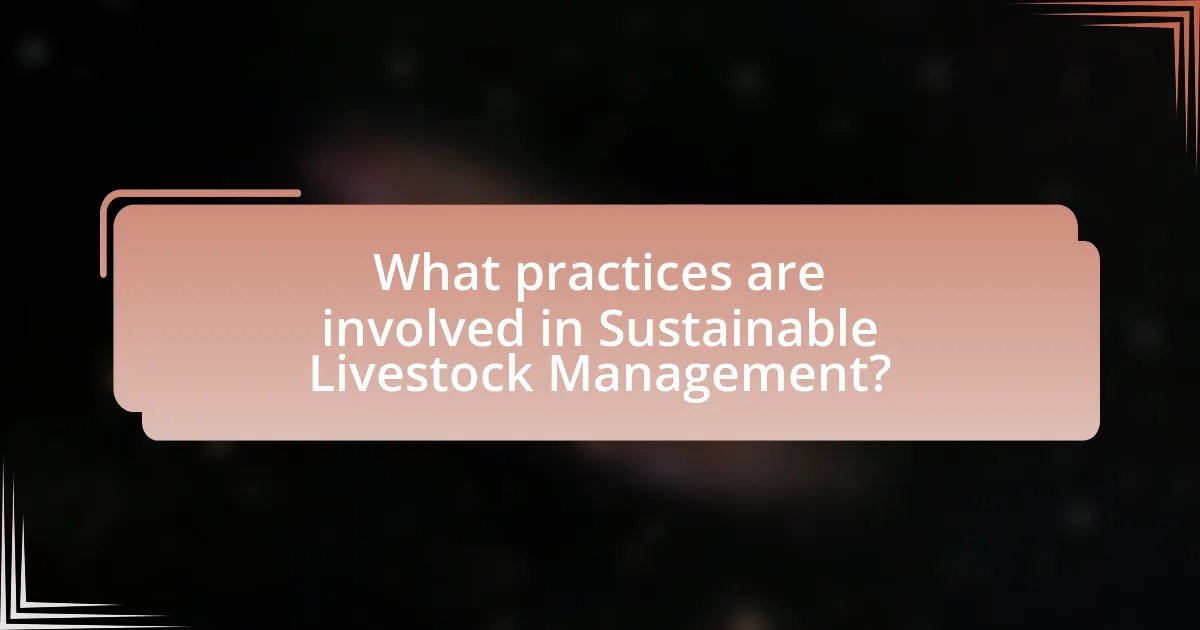
What practices are involved in Sustainable Livestock Management?
Sustainable livestock management involves practices such as rotational grazing, integrated crop-livestock systems, and improved feed efficiency. Rotational grazing enhances pasture health and reduces soil erosion by allowing land to recover between grazing periods. Integrated crop-livestock systems optimize land use and nutrient cycling, leading to reduced reliance on chemical fertilizers. Improved feed efficiency minimizes methane emissions from enteric fermentation in ruminants, contributing to lower greenhouse gas emissions. These practices collectively support environmental sustainability while maintaining livestock productivity.
How can feed management reduce greenhouse gas emissions?
Feed management can reduce greenhouse gas emissions by optimizing the nutritional content and digestibility of livestock feed, which enhances animal performance and reduces methane production during digestion. Research indicates that improving feed efficiency can lead to a decrease in enteric fermentation, a significant source of methane emissions in ruminants. For instance, a study published in the journal “Animal Feed Science and Technology” found that diets high in digestible fiber and low in starch can reduce methane emissions by up to 30%. By implementing targeted feed management strategies, livestock producers can effectively lower their carbon footprint while maintaining productivity.
What types of feed are most effective for reducing emissions?
Seaweed-based feeds are most effective for reducing emissions in livestock. Research indicates that incorporating seaweed, particularly Asparagopsis taxiformis, into cattle diets can reduce methane emissions by up to 80%. This significant reduction is attributed to the bioactive compounds in seaweed that inhibit the enzymes responsible for methane production during digestion. Studies, such as those published in the journal “Nature” by Roque et al. (2021), provide evidence of the efficacy of seaweed as a feed additive in mitigating greenhouse gas emissions from ruminants.
How does feed efficiency impact overall emissions?
Feed efficiency directly impacts overall emissions by determining the amount of feed required for livestock to produce a unit of meat or milk. Higher feed efficiency means that animals convert feed into body mass more effectively, resulting in lower greenhouse gas emissions per unit of product. For instance, research indicates that improving feed efficiency can reduce methane emissions from ruminants by up to 30%, as less feed intake leads to decreased fermentation processes that produce methane. Therefore, enhancing feed efficiency is a critical strategy in sustainable livestock management to mitigate greenhouse gas emissions.
What role does manure management play in Sustainable Livestock Management?
Manure management is crucial in sustainable livestock management as it minimizes greenhouse gas emissions and enhances nutrient recycling. Effective manure management practices, such as composting and anaerobic digestion, reduce methane and nitrous oxide emissions, which are potent greenhouse gases. According to the Food and Agriculture Organization, proper manure management can decrease methane emissions by up to 50% and improve soil health by returning nutrients to the land. This not only supports sustainable agricultural practices but also contributes to climate change mitigation efforts.
How can manure be utilized to minimize greenhouse gas emissions?
Manure can be utilized to minimize greenhouse gas emissions through practices such as anaerobic digestion and composting. Anaerobic digestion converts manure into biogas, which can replace fossil fuels, thereby reducing methane emissions that would otherwise occur from manure decomposition. According to the U.S. Environmental Protection Agency, anaerobic digestion can reduce methane emissions by up to 90%. Composting manure not only stabilizes nutrients but also reduces nitrous oxide emissions, as the process promotes aerobic conditions that limit the production of this potent greenhouse gas. Research indicates that composting can decrease nitrous oxide emissions by 30-50% compared to untreated manure. These methods effectively transform manure into valuable resources while mitigating greenhouse gas emissions.
What are the best practices for manure storage and application?
The best practices for manure storage and application include using covered storage facilities, implementing proper aeration, and applying manure at agronomically appropriate times. Covered storage minimizes nutrient loss and reduces odor, while proper aeration helps to manage moisture levels and prevent anaerobic conditions that can lead to methane emissions. Applying manure during optimal growing seasons ensures that nutrients are utilized effectively by crops, thereby reducing the risk of runoff and greenhouse gas emissions. Research indicates that these practices can significantly lower methane and nitrous oxide emissions associated with manure management, contributing to more sustainable livestock operations.
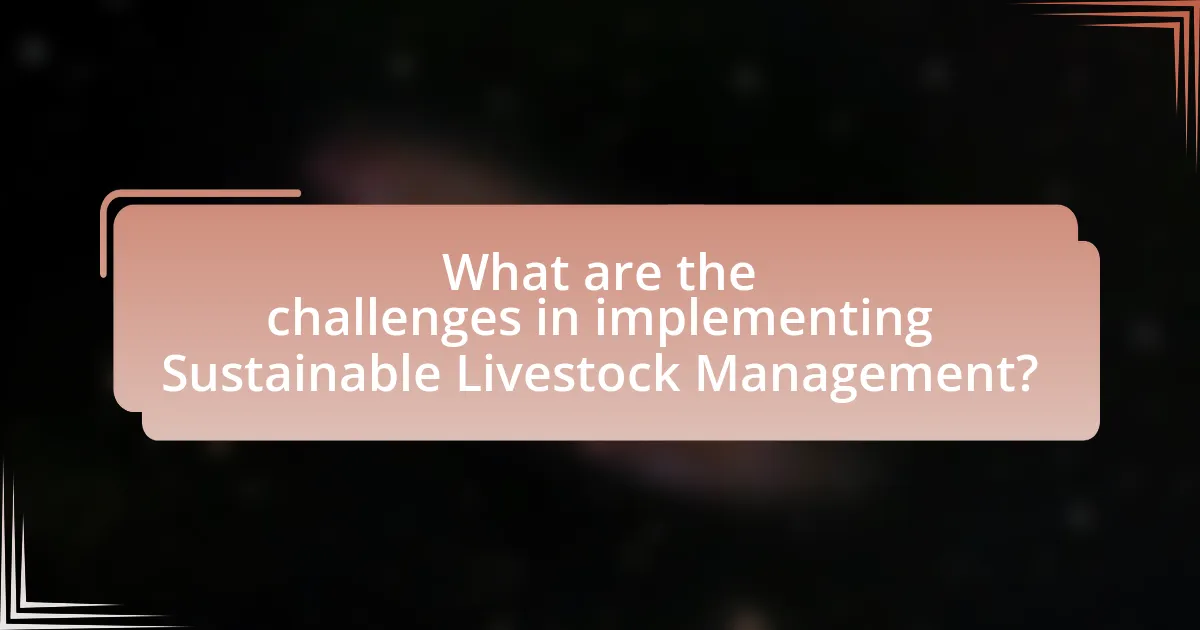
What are the challenges in implementing Sustainable Livestock Management?
The challenges in implementing Sustainable Livestock Management include economic constraints, lack of knowledge and training, and regulatory barriers. Economic constraints arise from the initial investment required for sustainable practices, which can deter farmers from adopting them. A study by the Food and Agriculture Organization (FAO) highlights that many livestock producers lack access to information and training on sustainable practices, leading to ineffective implementation. Additionally, regulatory barriers can complicate the adoption of sustainable methods, as inconsistent policies across regions may hinder farmers’ ability to comply with sustainability standards. These factors collectively impede the transition to more sustainable livestock management practices.
What barriers do farmers face in adopting sustainable practices?
Farmers face several barriers in adopting sustainable practices, including financial constraints, lack of knowledge, and limited access to resources. Financial constraints often arise from the high initial costs associated with implementing sustainable technologies and practices, which can deter farmers from making the transition. A study by the Food and Agriculture Organization (FAO) highlights that many farmers lack the capital needed for investments in sustainable methods, leading to a reliance on traditional practices that may be less environmentally friendly. Additionally, a lack of knowledge about sustainable practices and their benefits can hinder adoption, as farmers may not be aware of effective methods or may lack training. Furthermore, limited access to resources such as technical support, information, and markets for sustainably produced goods can create significant obstacles. These barriers collectively impede the widespread adoption of sustainable livestock management practices aimed at reducing greenhouse gas emissions.
How can economic factors influence the adoption of Sustainable Livestock Management?
Economic factors significantly influence the adoption of Sustainable Livestock Management by affecting the cost-benefit analysis for farmers. When sustainable practices, such as rotational grazing or integrated pest management, require upfront investments, farmers may hesitate to adopt them unless they perceive long-term financial benefits. For instance, a study by the Food and Agriculture Organization (FAO) indicates that farms implementing sustainable practices can reduce feed costs by up to 30% over time, demonstrating potential economic advantages. Additionally, market demand for sustainably produced livestock products can drive adoption; consumers are increasingly willing to pay premium prices for products that are environmentally friendly, thus incentivizing farmers to transition to sustainable methods.
What are the social challenges associated with changing livestock management practices?
Changing livestock management practices presents several social challenges, including resistance from farmers, knowledge gaps, and impacts on rural communities. Farmers often resist changes due to traditional practices, economic concerns, and fear of the unknown, which can hinder the adoption of sustainable methods. Additionally, there is often a lack of access to education and resources, leading to knowledge gaps about new practices and technologies. This can result in unequal implementation across different regions, exacerbating existing inequalities. Furthermore, shifts in livestock management can disrupt local economies and social structures, particularly in rural areas where livestock farming is a primary livelihood, leading to potential job losses and community disintegration.
How can technology aid in Sustainable Livestock Management?
Technology can aid in Sustainable Livestock Management by enhancing efficiency and reducing greenhouse gas emissions through precision farming, data analytics, and innovative feeding practices. Precision farming technologies, such as GPS and IoT sensors, allow farmers to monitor livestock health and optimize resource use, leading to lower emissions. Data analytics can identify patterns in livestock management that contribute to emissions, enabling targeted interventions. Additionally, advancements in feed formulation, including the use of additives that reduce methane production during digestion, have been shown to decrease greenhouse gas emissions significantly. For instance, research indicates that incorporating seaweed into cattle diets can reduce methane emissions by up to 80%.
What innovations are currently being used to reduce emissions in livestock farming?
Innovations currently being used to reduce emissions in livestock farming include the use of feed additives, precision livestock farming technologies, and improved manure management practices. Feed additives, such as seaweed and tannins, have been shown to significantly lower methane emissions from ruminants; for instance, a study published in the journal Nature found that adding seaweed to cattle diets can reduce methane emissions by up to 80%. Precision livestock farming technologies utilize sensors and data analytics to monitor animal health and optimize feeding practices, leading to more efficient resource use and lower emissions. Additionally, improved manure management practices, such as anaerobic digestion, convert waste into biogas, reducing greenhouse gas emissions while generating renewable energy. These innovations collectively contribute to more sustainable livestock management and lower overall greenhouse gas emissions.
How can data analytics improve livestock management practices?
Data analytics can significantly improve livestock management practices by enabling farmers to make data-driven decisions that enhance productivity and sustainability. By analyzing data on animal health, feed efficiency, and environmental conditions, farmers can optimize feeding strategies, monitor herd health in real-time, and reduce waste. For instance, a study published in the Journal of Dairy Science found that data analytics applications led to a 10% increase in milk production by identifying optimal feeding times and quantities. Additionally, predictive analytics can forecast disease outbreaks, allowing for timely interventions that minimize antibiotic use and greenhouse gas emissions associated with livestock production.
What are the best practices for farmers to implement Sustainable Livestock Management?
Farmers can implement Sustainable Livestock Management by adopting practices such as rotational grazing, integrated crop-livestock systems, and precision feeding. Rotational grazing enhances pasture health and reduces soil erosion, while integrated systems optimize land use and nutrient cycling. Precision feeding minimizes feed waste and lowers methane emissions from livestock digestion. Research indicates that these practices can significantly reduce greenhouse gas emissions, with studies showing that rotational grazing can decrease emissions by up to 30% compared to conventional methods.
How can farmers measure the effectiveness of their sustainable practices?
Farmers can measure the effectiveness of their sustainable practices by utilizing specific metrics such as greenhouse gas emissions reductions, soil health indicators, and biodiversity assessments. For instance, farmers can track the decrease in methane emissions from livestock through regular monitoring and reporting, which can be quantified using tools like the Greenhouse Gas Protocol. Additionally, soil health can be evaluated through tests that measure organic matter content and microbial activity, providing insights into the impact of practices like cover cropping and reduced tillage. Biodiversity assessments can be conducted by monitoring species diversity and abundance in pastures, which reflects the ecological benefits of sustainable practices. These methods provide concrete data that validate the effectiveness of sustainable practices in livestock management.
What resources are available for farmers looking to adopt sustainable practices?
Farmers looking to adopt sustainable practices can access a variety of resources, including government programs, educational materials, and financial assistance. For instance, the USDA offers the Environmental Quality Incentives Program (EQIP), which provides financial and technical assistance to implement conservation practices. Additionally, organizations like the Sustainable Agriculture Research and Education (SARE) program provide grants and educational resources focused on sustainable farming techniques. Research indicates that adopting these practices can significantly reduce greenhouse gas emissions, with studies showing that sustainable livestock management can lower emissions by up to 30%.

